Searching for Chaos Evidence in Eye Movement Signals
Abstract
1. Introduction
1.1. Eye Movement Basis
1.2. Contribution
- The analysis of eye movement signal in terms of chaotic features existence in the time series defined based on horizontal eye movement velocity:
- evaluation of the correlation dimension for various length of the measurement sets;
- estimation of the entropy for different time intervals of the fixation duration;
- analysis of the temporal correlation existence in the sets of measurement.
- The comparative analysis of data before and after noise reduction.
- The comparative analysis of the obtained results and characteristics of the Largest Lyapunov Exponent.
2. Theory
- Time lag—the most common approach, adopted for this purpose, is the evaluation of mutual information between measurements calculated in the form of the averaged mutual information factor (Equation (3)):where Ph and Pk denote the probabilities that the signal assumes a value within the h-th and k-th intervals respectively, and Ph,k(τ) is the joint probability that xi is taken from interval h and xi + τ from interval k [24].
- Embedding dimension—for estimating the second of the aforementioned parameters the False Nearest Neighbours (FNN) method proposed in [25] is used. According to this method, yiNN is the nearest neighbour of yi when the ratio of distances between these points seen in the dimension m + 1 and in dimension m, is less than the predefined threshold R—Equation (4):where and are additional components of vector y(i) in m + 1 dimensional space and yi and yiNN are vectors of m coordinates. According to Takens’ theorem [26], a system attractor can be restored correctly, if the embedding dimension m satisfies the condition: m ≥ 2d + 1, where d represents the dimension of an attractor.The estimation of phase space parameters enables further analysis aimed at system classification and identification based on analysis of phase space trajectories. Deterministic dynamical systems evolving typically towards an attractor, are characterized by a dimension less than the full phase space, whereas random time series are supposed to fill the embedding space. In order to quantify these occurrences, fractal or chaos methods, in the form of the fractal dimension and Lyapunov Exponents respectively, may be applied.
- Largest Lyapunov Exponents—two similar algorithms were proposed by Kantz [27] and Rosenstein [28] for calculating this exponent as:where dj is the Euclidean distance between a j-th pair of the nearest neighbours after time steps ∆t = ti − t0 and dj0 is the initial separation of neighbours in a considered pair.
- Fractal Dimension—although, there are several algorithms for ascertaining the fractal dimension, the method most commonly used is the correlation dimension first introduced by Grassberger and Procaccia [29]. It is based on a correlation sum being a collection of a fraction, or all possible pairs of points, which are closer than a particular distance r (Equations (6) and (7)):where H is the Heaviside function defined as follows:The correlation dimension of the dynamic system attractor is defined as the limit:
- Estimation of required measurements number ‒ according to [30] the upper limit on a reliable estimation of D2 is feasible when the number N of data points in the time series is given by:When reversing the question and asking: what is a correlation dimension, which can be reliably calculated with N samples, we obtain:
- Temporal Correlation—to avoid a problem of a temporal correlation present in measurements [31] the points to be considered in the correlation sum must be separated by tmin = w × ∆t, where w is the number of points excluded from the calculation and is called the Theiler window [32]. This entails changes in the formula of C(r):The Theiler window may be determined by multiplying the earlier estimated time lag by three or by analysis of the space-time separation plot, introduced by [33], which shows lines of constant probability for distribution of distances between pairs of points in function of time.
- Entropy—sensitivity of chaotic systems to initial conditions introduces some uncertainty in measurements. The rate of new information introduced during system evolvement may be assessed by the correlation entropy K2 defined—based on the correlation sum C(m, r) evaluated for sets of embedding dimensions m and radiuses r—as [31]:
3. Materials and Methods
4. Results
4.1. Correlation Dimension Exlploration
- 0.0018 and 0.0055, giving log(r) between −2.74 and −3.26, for the BNR time series,
- 0.001 and 0.003, giving log(r) between −3 and −2.52 for the ANR time series.
4.2. Computation of Entropy
5. Discussion
- the correlation dimension for eye movement time series may be reliably estimated when a set of measurements consists of 1000 and more samples, providing the opportunity to expand the possible scopes of the method application,
- the embedding dimension required—according to Taken’s theorem—to reconstruct a system’s phase space should at least be equal to 3 (m ≥ 2d + 1) assuming d = 1 as the first integer greater than the estimated correlation dimension.
6. Conclusions
Acknowledgments
Author Contributions
Conflicts of Interest
References
- Boon, M.Y.; Henry, B.I.; Suttle, C.M.; Dain, S.J. The correlation dimension: A useful objective measure of the transient visual evoked. J. Vis. 2008, 8, 1–21. [Google Scholar] [CrossRef] [PubMed]
- Kuusela, T.A.; Jartti, T.T.; Tahvanainen, K.U.O.; Kaila, T.J. Nonlinear methods of biosignal analysis in assessing terbutaline-induced heart rate and blood pressure changes. J. Physiol. Heart Circ. Physiol. 2002, 282, H773–H781. [Google Scholar] [CrossRef] [PubMed]
- Voss, A.; Schulz, S.; Schroeder, R.; Baumert, M.; Caminal, P. Methods derived from nonlinear dynamics for analysing heart rate variability. Phil. Trans. R. Soc. A 2009, 367, 277–296. [Google Scholar] [CrossRef] [PubMed]
- Cheng-Chi, W.; Jang, M.J.; Pai, N.S. Bifurcation and nonlinear dynamic analysis of heart blood vessel system. In Proceedings of the 2012 International Conference on IEEE Mechatronics and Automation (ICMA), Chengdu, China, 5–8 August 2012. [Google Scholar]
- Van Emmerik, R.E.A.; Ducharme, S.W.; Amado, C.A.; Hamill, J. Comparing dynamical systems concepts and techniques for biomechanical analysis. J. Sport Health Sci. 2016, 5, 3–13. [Google Scholar] [CrossRef]
- Terrier, P.; Driaz, O. Nonlinear dynamics of human locomotion: Effects of rhythmic auditory cueing on local dynamic stability. Front. Physiol. 2013, 4, 230. [Google Scholar] [CrossRef] [PubMed]
- Korn, H.; Faure, P. Is there chaos in the brain? II. Experimental evidence and related models. C. R. Biol. 2003, 326, 787–840. [Google Scholar] [CrossRef] [PubMed]
- Rodrıguez-Bermudez, G.; Garcıa-Laencina, P.J. Analysis of EEG Signals using Nonlinear Dynamics and Chaos. A review. Appl. Math. Inf. Sci. 2015, 9, 2309–2321. [Google Scholar]
- Catz, N.; Their, P. Neural control of saccadic eye movements. Dev. Ophthalmol. 2007, 40, 52–75. [Google Scholar] [CrossRef] [PubMed]
- Holmqvist, K. Eye Tracking: A Comprehensive Guide to Methods and Measures, 3rd ed.; Oxford University Press: Oxford, UK, 2015; pp. 154–196. [Google Scholar]
- Harezlak, K.; Kasprowski, P. Evaluating Quality of Dispersion Based Fixation Detection Algorithm. In Information Sciences and Systems 2014; Czachórski, T., Gelenbe, E., Lent, R., Eds.; Springer: Cham, Switzerland, 2014; pp. 97–104. [Google Scholar]
- Robinson, D.A. Models of the saccadic eye movement control system. Kybernetik 1973, 14, 71–83. [Google Scholar] [CrossRef] [PubMed]
- Komogortsev, O.; Holland, C.; Jayarathna, S.; Karpov, A. 2D Linear oculomotor plant mathematical model: Verification and biometric applications. ACM Trans. Appl. Percept. 2013, 10, 27. [Google Scholar] [CrossRef]
- Engbert, R.; Mergenthaler, K.; Sinn, P.; Pikovsky, A. An integrated model of fixational eye movements and microsaccades. Proc. Natl. Acad. Sci. USA 2011, 108, E765–E770. [Google Scholar] [CrossRef] [PubMed]
- Martinez-Conde, S.; Macknik, S.L.; Hubel, D.H. The role of fixational eye movements in visual perception. Nat. Neurosci. 2004, 5, 229–240. [Google Scholar] [CrossRef] [PubMed]
- Martinez-Conde, S.; Otero-Millan, J.; Macknik, S.L. The impact of microsaccades on vision: Towards a unified theory of saccadic function. Nat. Rev. Neurosci. 2013, 14, 83–96. [Google Scholar] [CrossRef] [PubMed]
- Aştefănoaei, C.; Pretegiani, E.; Optican, L.M.; Creangă, D.; Rufa, A. Eye Movement Recording and Nonlinear Dynamics Analysis—The Case Of Saccades. Rom. J. Biophys. 2013, 23, 81–92. [Google Scholar] [PubMed]
- Aştefănoaei, C.; Creangă, D.; Pretegiani, E.; Optican, L.M.; Rufa, A. Dynamical Complexity Analysis Of Saccadic Eye Movements In Two Different Psychological Conditions. Rom. Rep. Phys. 2014, 66, 1038–1055. [Google Scholar] [PubMed]
- Murata, A.; Matsuura, T. Nonlinear dynamical analysis of eye movement characteristics using attractor plot and first lyapunov exponent. In Lecture Notes in Computer Science (Including Subseries Lecture Notes in Artificial Intelligence and Lecture Notes in Bioinformatics); Springer International Publishing: Cham, Switzerland, 2015; Volume 9170, pp. 78–85. [Google Scholar]
- Hampson, K.M.; Cufflin, M.P.; Mallen, E.A.H. Sensitivity of Chaos Measures in Detecting Stress in the Focusing Control Mechanism of the Short-Sighted Eye. Bull. Math. Biol. 2017, 79, 1870–1887. [Google Scholar] [CrossRef] [PubMed]
- Harezlak, K. Eye movement dynamics during imposed fixations. Inf. Sci. 2017, 384, 249–262. [Google Scholar] [CrossRef]
- Harezlak, K.; Kasprowski, P. Chaotic Nature of Eye Movement Signal. In Intelligent Decision Technologies 2017, Proceedings of the 9th KES International Conference on Intelligent Decision Technologies (KES-IDT 2017)—Part I, Algarve, Portugal, 21–23 June 2017; Czarnowski, I., Howlett, R., Jain, L., Eds.; Springer International Publishing: Cham, Switzerland, 2018; Volume 72, pp. 120–129. [Google Scholar] [CrossRef]
- Abarbanel, H.D.I. Analysis of Observed Chaotic Data. Institute for Nonlinear Science, 1st ed.; Springer: New York, NY, USA, 1996; ISBN 978-03879837. [Google Scholar]
- Fraser, A.M.; Swinney, H.L. Independent coordinates for strange attractors from mutual information. Phys. Rev. A Gen. Phys. 1986, 33, 1134–1140. [Google Scholar] [CrossRef] [PubMed]
- Kennel, M.B.; Brown, R.; Abarbanel, H.D.I. Determining embedding dimension for phase space reconstruction using a geometrical construction. Phys. Rev. A 1992, 45, 3403–3411. [Google Scholar] [CrossRef] [PubMed]
- Takens, F. Detecting strange attractors in fluid turbulence. In Dynamical Systems and Turbulence; Lecture Notes in Mathematics; Rand, D., Youn, L.S., Eds.; Springer: Berlin, Germany, 1981; Volume 898, p. 366. ISBN 978-3-540-11171-9. [Google Scholar]
- Kantz, H. A robust method to estimate the maximal Lyapunov exponent of a time series. Phys. Lett. A 1994, 185, 77–87. [Google Scholar] [CrossRef]
- Rosenstein, M.T.; Collins, J.J.; De Luca, C.J. A practical method for calculating largest Lyapunov exponents from small data sets. Phys. D 1993, 65, 117–134. [Google Scholar] [CrossRef]
- Grassberger, P.; Procaccia, I. Characterization of Strange Attractors. Phys. Rev. Lett. 1983, 50, 346–349. [Google Scholar] [CrossRef]
- Eckmann, J.P.; Ruelle, D. Fundamental limitations for estimating dimensions and Lyapunov exponents in dynamical systems. Phys. D Nonlinear Phenom. 1992, 56, 185–187. [Google Scholar] [CrossRef]
- Kantz, H.; Schreiber, T. Nonlinear Time Series Analysis. Cambridge Nonlinear Science Series; Cambridge University Press: Cambridge, UK, 1997. [Google Scholar]
- Theiler, J. Spurious dimension from correlation algorithms applied to limited time-series data. Phys. Rev. A Gen. Phys. 1986, 34, 2427–2432. [Google Scholar] [CrossRef] [PubMed]
- Provenzale, A.; Smith, L.A.; Vio, R.; Murante, G. Distinguishing between low-dimensional dynamics and randomness in measured time series. Phys. D Nonlinear Phenom. 1992, 58, 31–49. [Google Scholar] [CrossRef]
- Jazz Novo. Ober Consulting, 2015. Available online: http://www.ober-consulting.com/product/jazz/ (accessed on 30 December 2017).
- Binias, B.; Palus, H.; Jaskot, K. Real-Time Detection and Filtering of Eye Movement and Blink Related Artifacts in EEG. In Man—Machine Interactions 4; Gruca, A., Brachman, A., Kozielski, S., Czachórski, T., Eds.; Springer International Publishing: Cham, Switzerland, 2016; Volume 391, pp. 903–908. [Google Scholar]
- Wang, D.; Mulvey, F.B.; Pelz, J.B.; Holmqvist, K. A study of artificial eyes for the measurement of precision in eye-trackers. Behav. Res. 2017, 49, 947–959. [Google Scholar] [CrossRef] [PubMed]
- Kasprowski, P.; Harezlak, K.; Stasch, M. Guidelines for the Eye Tracker Calibration Using Points of Regard. In Information Technologies in Biomedicine; Pietka, E., Kawa, J., Wieclawek, W., Eds.; Springer International Publishing: Cham, Switzerland, 2014; Volume 4, pp. 225–236. [Google Scholar] [CrossRef]
- Package ‘tseriesChaos’. Available online: https://cran.r-project.org/web/packages/tseriesChaos/tseriesChaos.pdf (accessed on 19 December 2017).
- Komogortsev, V.; Rigas, I. BioEye 2015: Competition on biometrics via eye movements. In Proceedings of the IEEE Seventh International Conference on Biometrics: Theory, Applications and Systems (BTAS), Arlington, VA, USA, 8–11 September 2015. [Google Scholar]
- Ramanauskas, N. Calibration of video-oculographical eye-tracking system. Electron Electr. Eng. 2006, 8, 65–68. [Google Scholar]
- Package ‘nonlinearTseries’. Available online: https://cran.r-project.org/web/packages/nonlinearTseries/nonlinearTseries.pdf (accessed on 19 December 2017).
- Hassan, S.A.; Ansari, M.R.K. Nonlinear analysis of seasonality and stochasticity of the Indus River. Hydrol. Sci. J. 2010, 55, 250–265. [Google Scholar] [CrossRef]
- Rapp, P.E.; Albano, A.M.; Schmah, T.I.; Farwell, L.A. Filtered noise can mimic low-dimensional chaotic attractors. Phys. Rev. E 1993, 47, 2289–2297. [Google Scholar] [CrossRef]
- Darrien, J.H.; Herd, K.; Starling, L.-J.; Rosenberg, J.R.; Morrison, J.D. An analysis of the dependence of saccadic latency on target position and target characteristics in human subjects. BMC Neurosci. 2001, 2, 1–8. [Google Scholar] [CrossRef]
- Harezlak, K.; Kasprowski, P.; Stasch, M. Towards Accurate Eye Tracker Calibration—Methods and Procedures. Procedia Comput. Sci. 2014, 35, 1073–1081. [Google Scholar] [CrossRef]
- Heathcote, A.; Elliott, D. Nonlinear dynamical analysis of noisy time series. Nonlinear Dyn. Psychol. Life Sci. 2005, 9, 399–433. [Google Scholar]
- Kasprowski, P.; Harezlak, K. Gaze Self-Similarity Plot—A New Visualization Technique. J. Eye Mov. Res. 2017, 10. [Google Scholar] [CrossRef]
- Sprott, J.C. Chaos and Time-Series Analysis; Oxford University Press: Oxford, UK; New York, NY, USA, 2003. [Google Scholar]
- Hirata, Y.; Aihara, K. Devaney’s chaos on recurrence plots. Phys. Rev. E 2010, 82, 036209. [Google Scholar] [CrossRef] [PubMed]
- Harezlak, K.; Kasprowski, P.; Dzierzega, M.; Kruk, K. Application of Eye Tracking for Diagnosis and Therapy of Children with Brain Disabilities. In Intelligent Decision Technologies 2016, Proceedings of the 8th KES International Conference on Intelligent Decision Technologies (KES-IDT 2016)—Part II, Tenerife, Spain, 15–17 June 2016; Czarnowski, I., Caballero, A., Howlett, R., Jain, L., Eds.; Springer: Cham, Switzerland, 2016; Volume 57, pp. 323–333. [Google Scholar] [CrossRef]
- Kasprowski, P.; Harezlak, K. VisDaT—Vision Diagnostics and Treatment System for Children with Disabilities. J. Healthcare Eng. 2017, submitted. [Google Scholar]
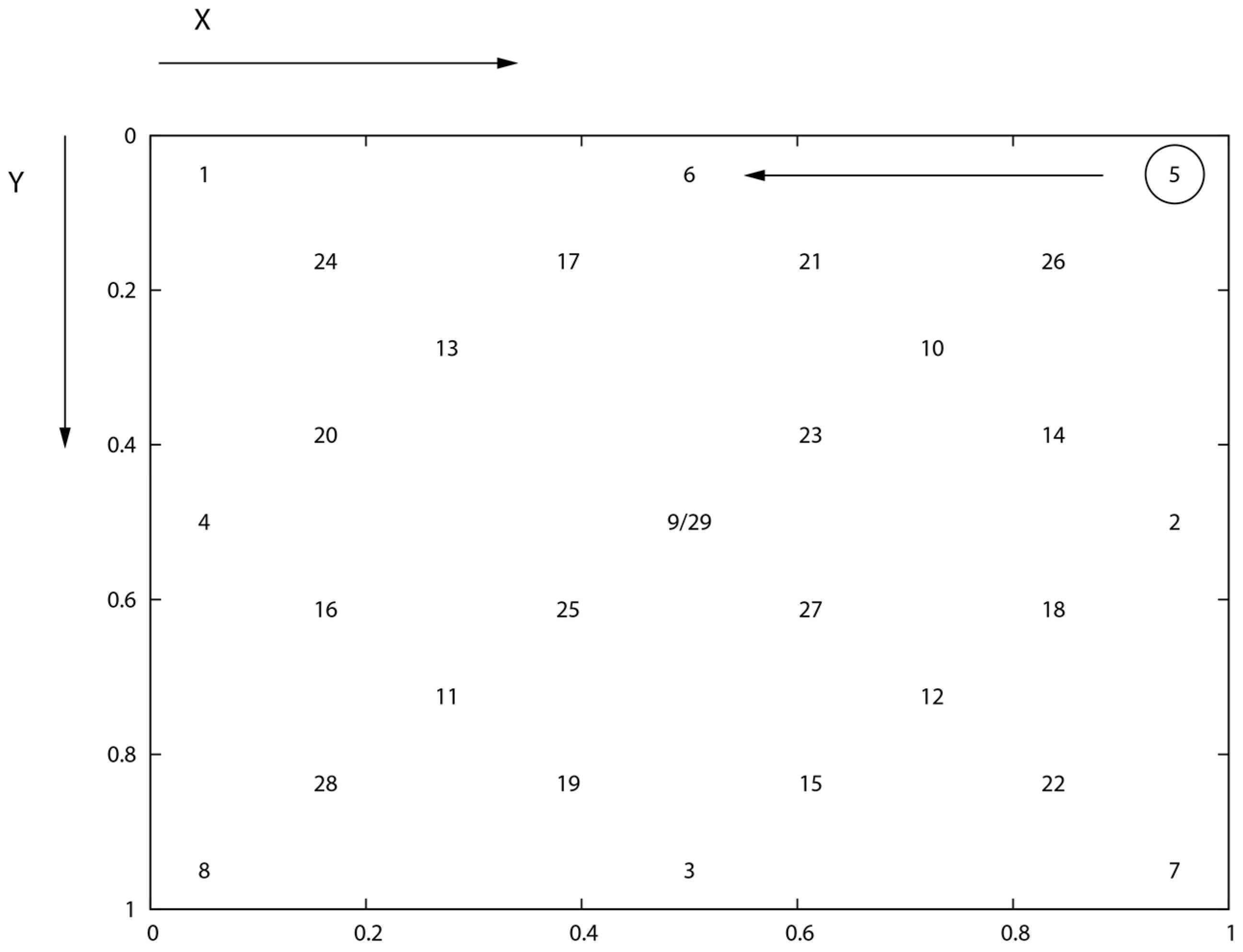
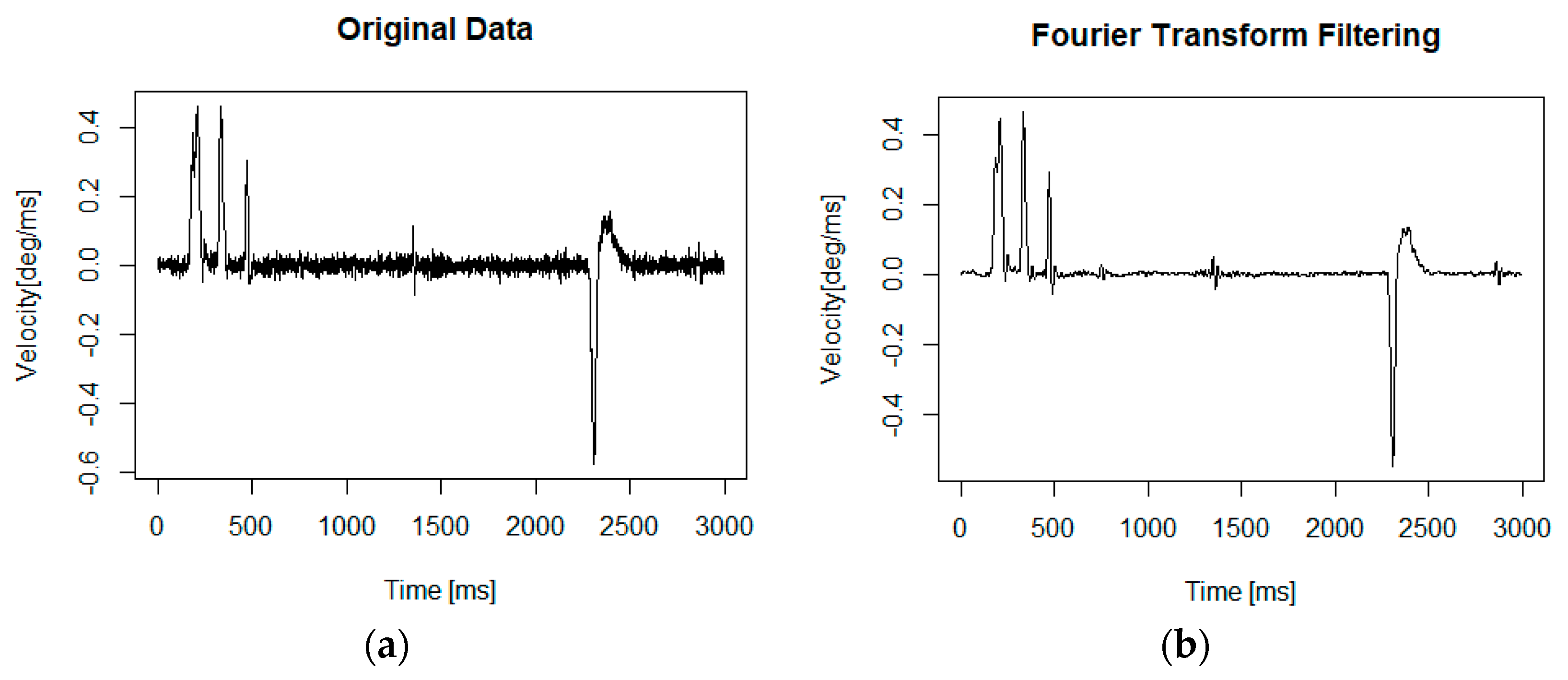
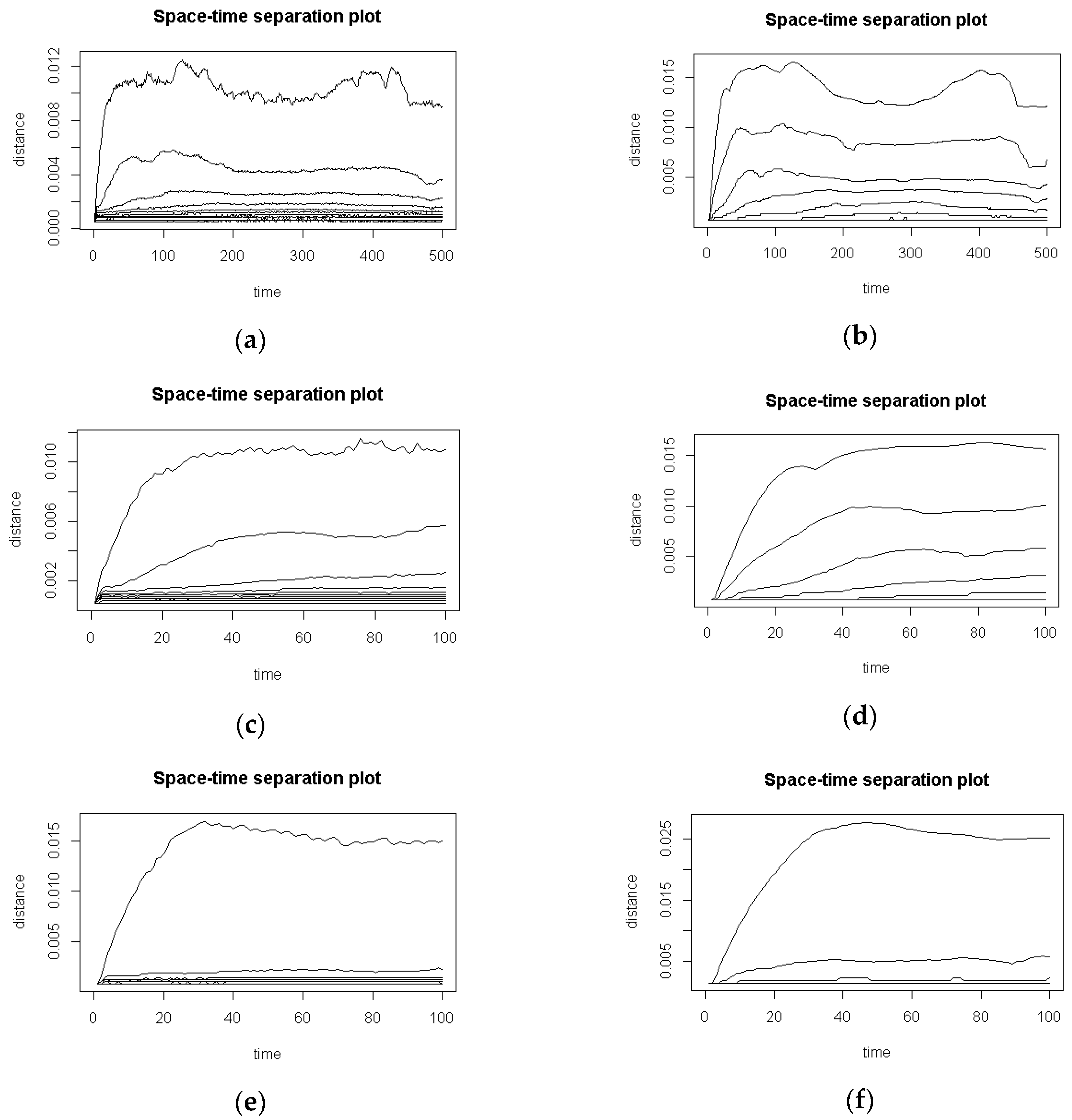
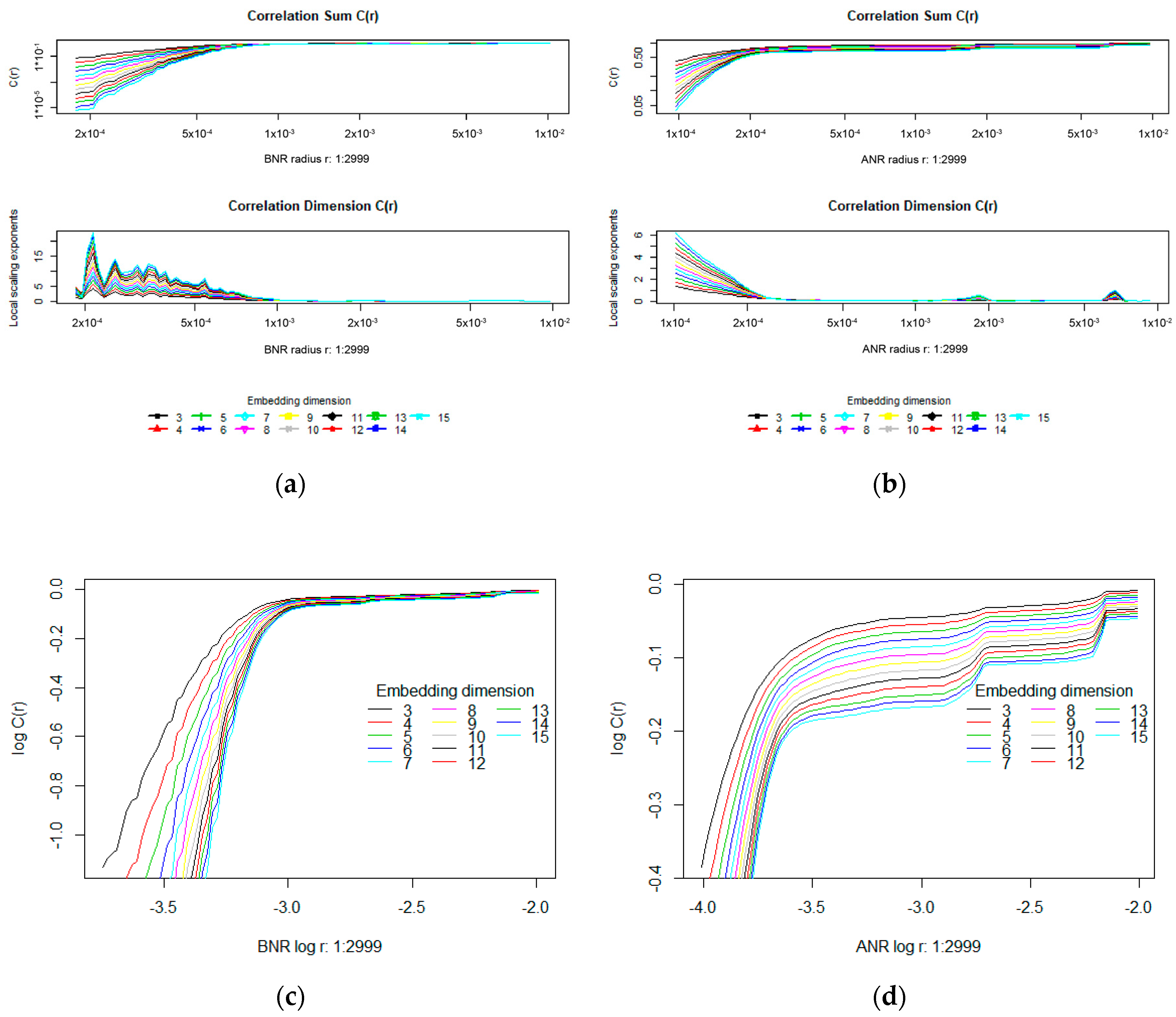
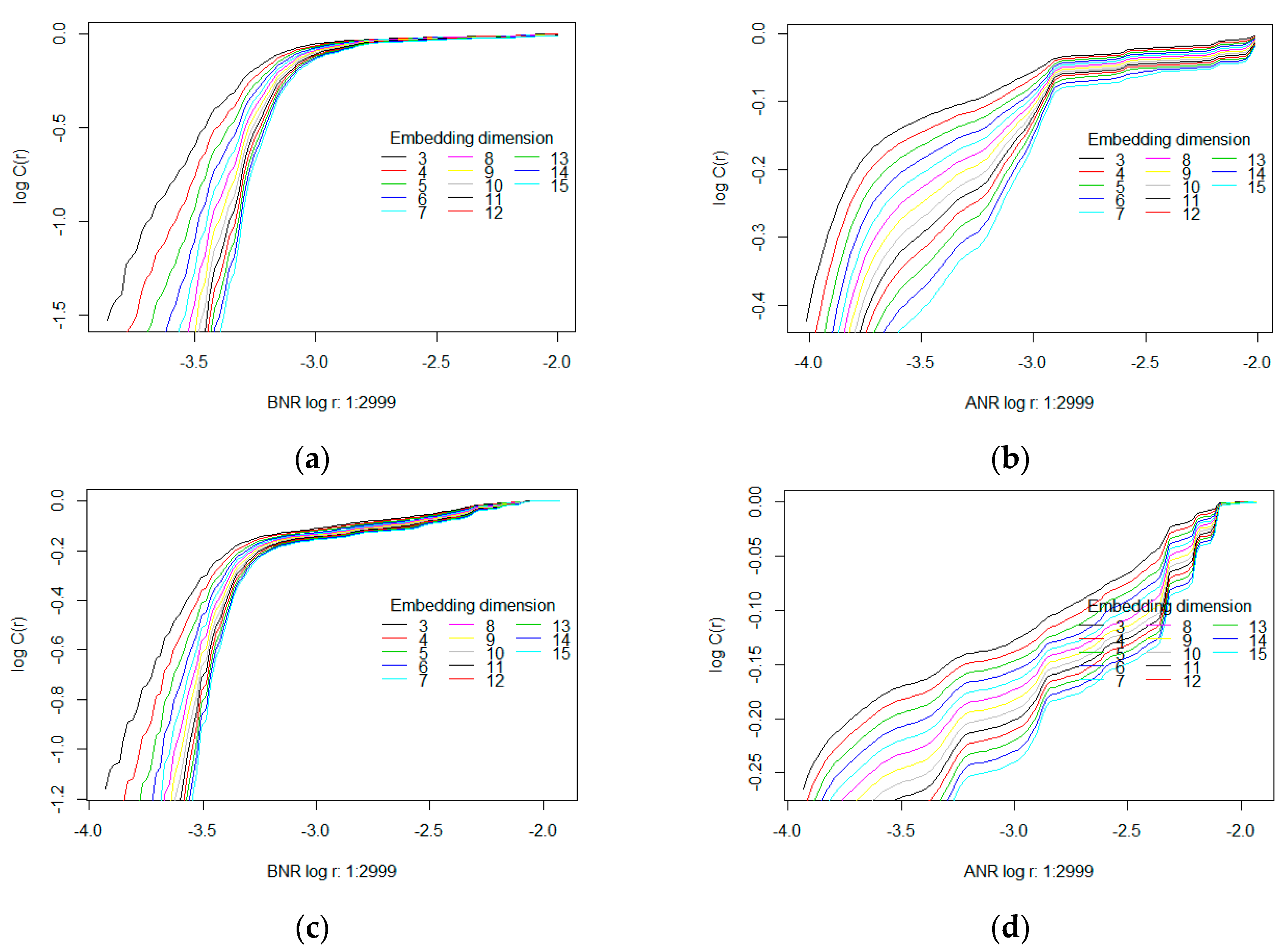


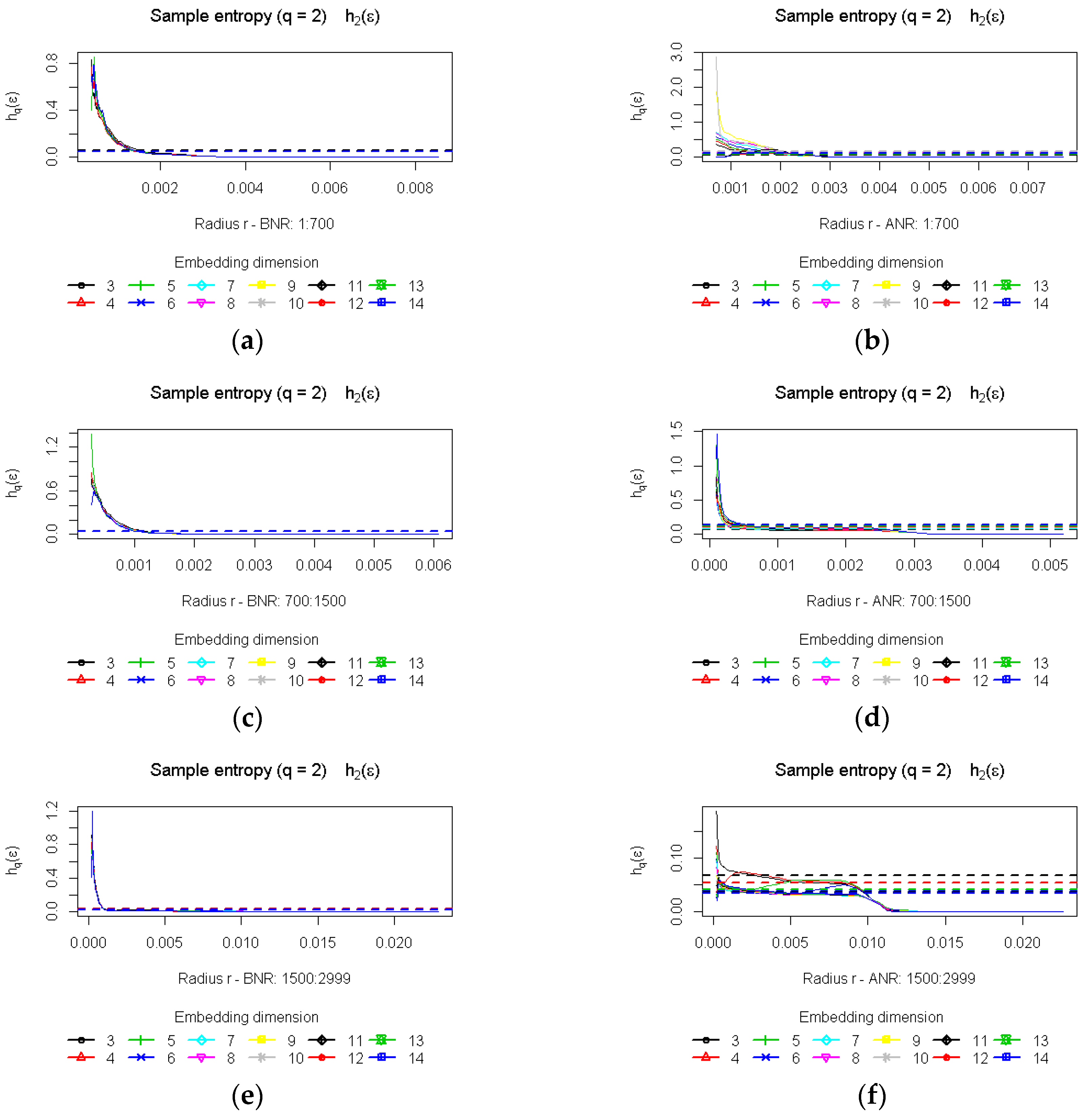


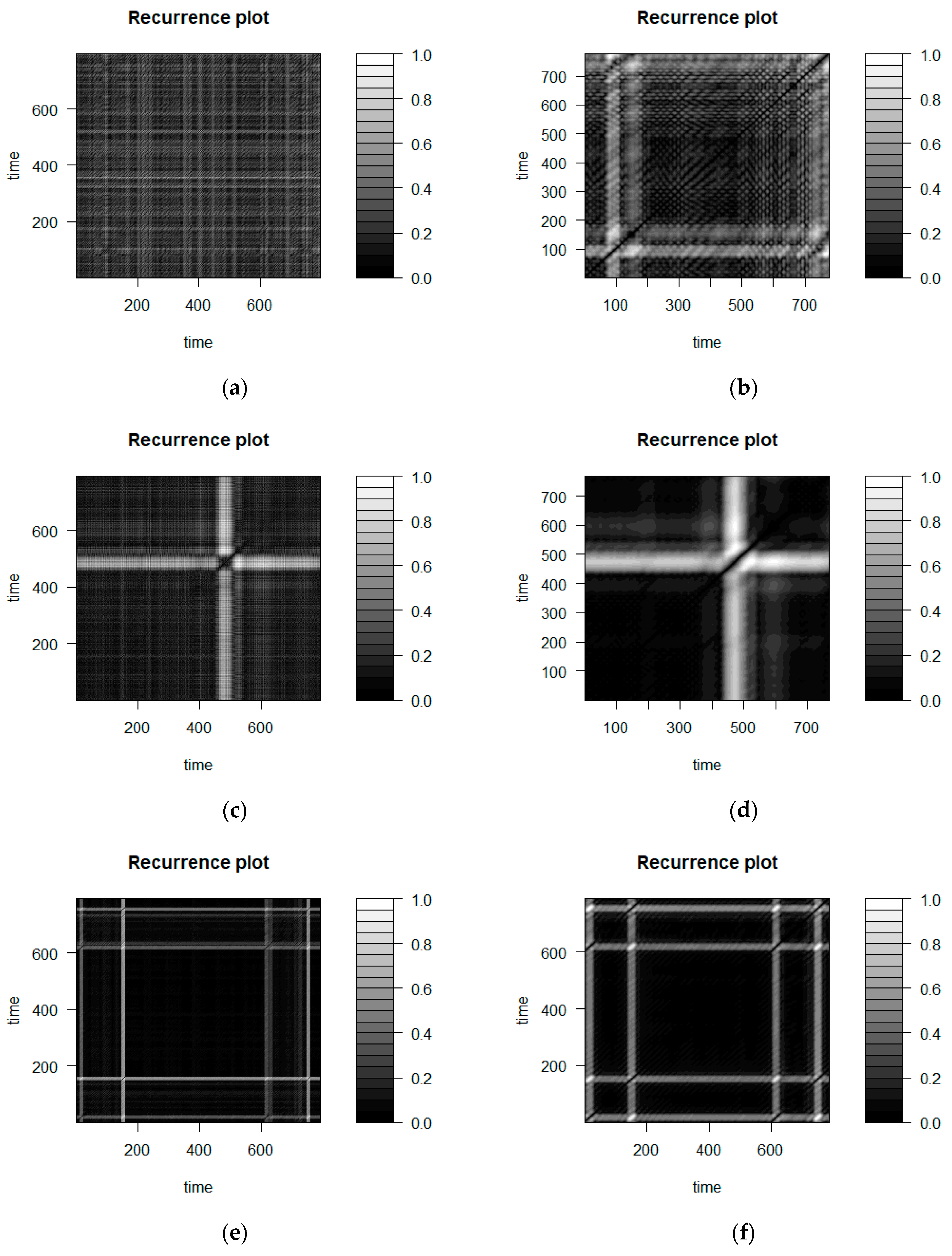
| Number of Measurements | 2log10N | Correlation Dimension |
|---|---|---|
| 1000 | 6 | ≤6 |
| 1500 | 6.3522 | ≤7 |
| 2999 | 6.9539 | ≤7 |
| TS Type | 1000 | 1500 | 2999 |
|---|---|---|---|
| BNR mean (stdev) | 0.39 (0.18) | 0.33 (0.14) | 0.27 (0.09) |
| ANR mean (stdev) | 0.49 (0.33) | 0.35 (0.23) | 0.24 (0.16) |
| BNR vs. ANR (p < 0.05) | 67% | 58% | 65% |
| TS Type | 1000 1500 | 1000 2999 | 1500 2999 |
|---|---|---|---|
| BNR (p < 0.05) | 41% | 88% | 60% |
| ANR (p < 0.05) | 50% | 90% | 60% |
| TS Type | <1…700> | <700…1500> | <1500…2999> |
|---|---|---|---|
| BNR mean (stdev) | 0.0480 (0.0141) | 0.0588 (0.0148) | 0.0542 (0.0203) |
| ANR mean (stdev) | 0.1066 (0.0370) | 0.0671 (0.0165) | 0.0589 (0.0120) |
| BNR vs. ANR (p value <0.005) | 95% | 60% | 47% |
| TS Type | <1…700> <700…1500> | <1…700> <1500…2999> | <700…1500> <1500…2999> |
|---|---|---|---|
| BNR (p < 0.05) | 63% | 52% | 21% |
| ANR (p < 0.05) | 90% | 96% | 54% |
© 2018 by the authors. Licensee MDPI, Basel, Switzerland. This article is an open access article distributed under the terms and conditions of the Creative Commons Attribution (CC BY) license (http://creativecommons.org/licenses/by/4.0/).
Share and Cite
Harezlak, K.; Kasprowski, P. Searching for Chaos Evidence in Eye Movement Signals. Entropy 2018, 20, 32. https://doi.org/10.3390/e20010032
Harezlak K, Kasprowski P. Searching for Chaos Evidence in Eye Movement Signals. Entropy. 2018; 20(1):32. https://doi.org/10.3390/e20010032
Chicago/Turabian StyleHarezlak, Katarzyna, and Pawel Kasprowski. 2018. "Searching for Chaos Evidence in Eye Movement Signals" Entropy 20, no. 1: 32. https://doi.org/10.3390/e20010032
APA StyleHarezlak, K., & Kasprowski, P. (2018). Searching for Chaos Evidence in Eye Movement Signals. Entropy, 20(1), 32. https://doi.org/10.3390/e20010032





